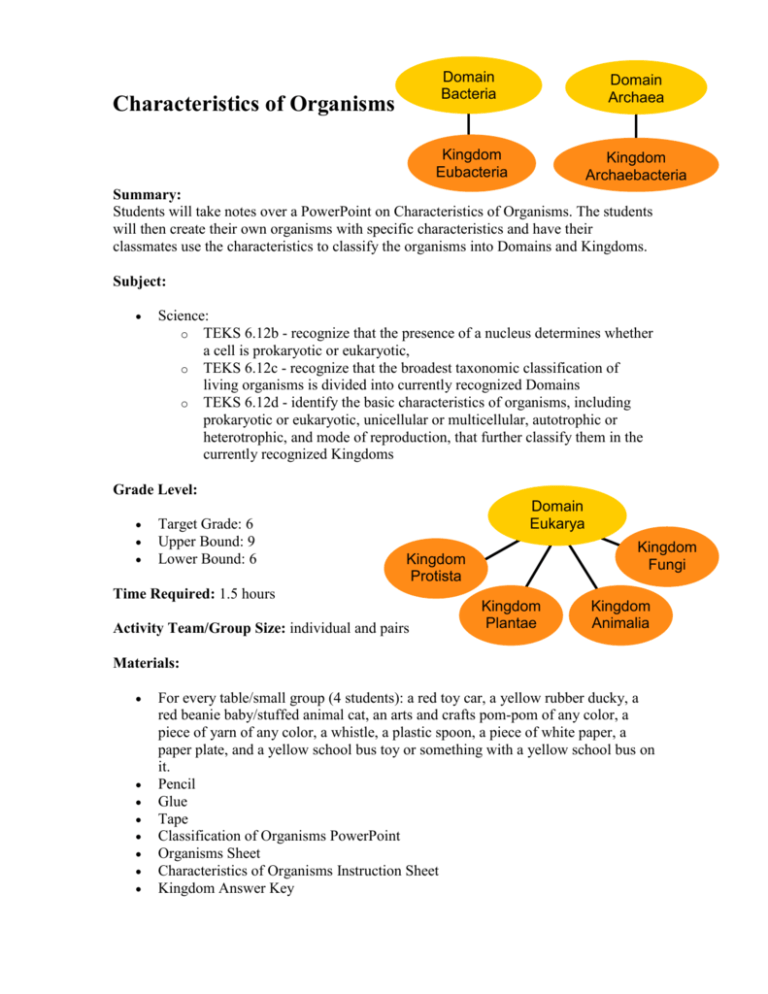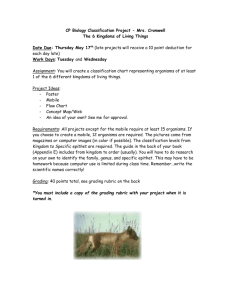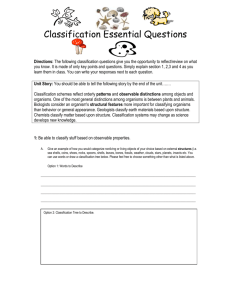Characteristics of Organisms
advertisement

Characteristics of Organisms Domain Bacteria Domain Archaea Kingdom Eubacteria Kingdom Archaebacteria Summary: Students will take notes over a PowerPoint on Characteristics of Organisms. The students will then create their own organisms with specific characteristics and have their classmates use the characteristics to classify the organisms into Domains and Kingdoms. Subject: Science: o TEKS 6.12b - recognize that the presence of a nucleus determines whether a cell is prokaryotic or eukaryotic, o TEKS 6.12c - recognize that the broadest taxonomic classification of living organisms is divided into currently recognized Domains o TEKS 6.12d - identify the basic characteristics of organisms, including prokaryotic or eukaryotic, unicellular or multicellular, autotrophic or heterotrophic, and mode of reproduction, that further classify them in the currently recognized Kingdoms Grade Level: Target Grade: 6 Upper Bound: 9 Lower Bound: 6 Domain Eukarya Kingdom Fungi Kingdom Protista Time Required: 1.5 hours Activity Team/Group Size: individual and pairs Kingdom Plantae Kingdom Animalia Materials: For every table/small group (4 students): a red toy car, a yellow rubber ducky, a red beanie baby/stuffed animal cat, an arts and crafts pom-pom of any color, a piece of yarn of any color, a whistle, a plastic spoon, a piece of white paper, a paper plate, and a yellow school bus toy or something with a yellow school bus on it. Pencil Glue Tape Classification of Organisms PowerPoint Organisms Sheet Characteristics of Organisms Instruction Sheet Kingdom Answer Key Organism Sorting Packet Learning Objectives: The student will list the differences between domains and between kingdoms and successfully classify 90% of organisms into the correct Kingdoms. Before the Lesson: You may want to cut out organisms on the Organisms Sheet before class begins. Lesson Introduction / Motivation: Give each table/group of four students 10 different objects: a red toy car, a yellow rubber ducky, a red beanie baby/stuffed animal cat, an arts and crafts pom-pom of any color, a piece of yarn of any color, a whistle, a plastic spoon, a piece of white paper, a paper plate, and a yellow school bus toy or something with a yellow school bus on it. Tell the students that they have five to ten minutes to group the objects into three or four different categories. After the time has passed, ask each group to explain the rationale for at least one of their groupings. After polling the entire class, point out that everyone had a slightly different method of classifying the objects. Now ask the students what they think would happen if they had been asked to classify every organism on Earth. (Answer: everyone would do it differently). Explain to students that there is one worldwide way that scientists use to classify and identify all organisms on Earth. Lesson Plan: Present the Classification of Organisms PowerPoint. Make sure students take notes. Afterwards, have students break into pairs or assign pairs. Give each pair of students a Ziploc bag with the Organisms sheet (cut up or whole) in it. Have students cut out the organisms if it has not already been done. Pass out the Characteristics of Organisms Instructions Sheet. Go through steps 1 to 3, making sure that students understand what they are going to do. After allowing them some time (15 to 20 minutes), stop the students and explain steps 4 to 7. Make sure the students write their name on all papers before they turn them in. When it seems like most students are ready for the next steps, explain steps 8 through 11. Make sure that they write their names and the students’ names that they switched with on their papers. Lesson Closure: Ask students if they think that this is a good classification method. Ask them why or why not. Have a class discussion and make sure to answer their questions or clarify misconceptions. Assessment: Grade the students twice: once for their correct classification of their classmate’s organisms and once for their correct Kingdom Answer Key for their own organisms. You may want to make this a major grade. Domain Kingdo Domain Bacteria Archea Eukary m Protista Plantae Fungi a Animali Archae Eubact bacteri eria a a Vocabulary: Domain Kingdom Classification Background and Concepts for Teachers: In the Classification of Organisms, there is now a higher tier than Kingdom. Domains divide organisms further. There are 3 Domains and 6 Kingdoms. Domain Archaea contains Kingdom Archaebacteria, Domain Bacteria contains Kingdom Eubacteria, and Domain Eukarya contains Kingdoms Animalia, Plantae, Fungi, and Protista. Lesson Scaling: If you have less time, split the lesson into two class periods. For the first class period just go through the PowerPoint and notes. Then allow students to complete the activity the second class day. Multimedia Support and Attachments: See attachments Authors: Graduate Fellow Name: Trevor Makal Teacher Mentor Name: ___ Undergraduate Fellow Name: Jillian Van Zandt Date Submitted: October 15, 2010 Date Last Edited: October 15, 2010 Please email us your comments on this lesson: E-mail to ljohnson@cvm.tamu.edu Please include the title of the lesson, whether you are a teacher, resident scientist or college faculty and what grade you used it for. Teacher’s Comments:







